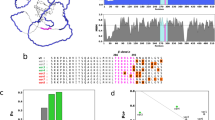Abstract
In the core binding factor (CBF)β-smooth muscle myosin heavy chain (SMMHC) acute myeloid leukemia (AML) oncoprotein, CBFβ lies N-terminal to the α-helical rod domain of SMMHC. Deletion of the SMMHC assembly competence domain (ACD), conserved among skeletal, smooth and nonmuscle myosins, prevents multimerization, inhibition of CBF and inhibition of cell proliferation. To define the amino acids critical for ACD function, three outer surface residues of ACD helices A–D, the subsequent helices E–H or the more N-terminal X or Z helices were now mutated. Variants were assessed for multimerization in low ionic strength in vitro and for nuclear localization as a measure of in vivo multimerization. Mutation of individual helices C–H reduced multimerization, with alteration of the outer surface of helices D or E having the greatest effect. The ability of these SMMHC variants to slow murine myeloid progenitor proliferation largely paralleled their effects on multimerization. Divergence at the boundaries of the ACD may reflect quantitative differences between in vitro and in vivo filament assembly. Each helix mutant retained the ability to bind the mSin3A corepressor. Agents interacting with the outer surface of the CBFβ-SMMHC ACD that prevent multimerization may be effective as novel therapeutics in AML.
This is a preview of subscription content, access via your institution
Access options
Subscribe to this journal
Receive 50 print issues and online access
$259.00 per year
only $5.18 per issue
Buy this article
- Purchase on Springer Link
- Instant access to full article PDF
Prices may be subject to local taxes which are calculated during checkout





Similar content being viewed by others
References
Atkinson SJ, Stewart M . (1991). J Cell Sci 99: 823–836.
Bernardin F, Friedman AD . (2002). Oncogene 21: 3247–3252.
Bernardin-Fried F, Kummalue T, Leijen S, Collector MI, Ravid K, Friedman AD . (2004). J Biol Chem 279: 15678–15687.
Burel SA, Harakawa N, Zhou L, Pabst T, Tenen DG, Zhang DE . (2001). Mol Cell Biol 21: 5577–5590.
Cao W, Adya M, Britos-Bray M, Liu PP, Friedman AD . (1998). J Biol Chem 273: 31534–31540.
Cao W, Britos-Bray M, Claxton DF, Kelley CA, Speck NA, Liu PP et al. (1997). Oncogene 15: 1315–1327.
Castilla LH, Garrett L, Adya N, Orlic D, Dutra A, Anderson S et al. (1999). Nat Genet 23: 144–146.
Castilla LH, Wijmenga C, Stacy T, Speck NA, Eckhaus M, Marin-Padilla M et al. (1996). Cell 87: 687–696.
Cohen C, Parry DAD . (1998). J Struct Biol 122: 180–187.
D'Costa J, Chaudhuri S, Civin CI, Friedman AD . (2005). Leukemia 19: 921–929.
Durst KL, Lutterbach B, Kummalue T, Friedman AD, Hiebert SW . (2003). Mol Cell Biol 23: 607–619.
Finer MH, Dull TJ, Qin L, Farson D, Roberts MR . (1994). Blood 83: 43–50.
Friedman AD . (1999). Leukemia 13: 1932–1942.
Hoppe PE, Waterston RH . (1996). J Cell Biol 135: 371–382.
Kummalue T, Lou J, Friedman AD . (2002). Mol Cell Biol 22: 8278–8291.
Landrette SF, Kuo YH, Hensen K, van Waalwijk van Doorn-Khosrovani SB, Perrat PN, Van de Ven WJM et al. (2005). Blood 105: 2900–2907.
Liu P, Tarle SA, Hajre A, Claxton DF, Marlton P, Freedman M et al. (1993). Science 261: 1041–1044.
Liu PP, Wijmenga C, Hajra A, Blake TB, Kelley CA, Adelstein RS et al. (1996). Genes Chromosome Cancer 16: 77–87.
Lou J, Cao W, Bernardin F, Ayyanathan K, Rauscher III FJ, Friedman AD . (2000). Oncogene 19: 2695–2703.
Moreno-Miralles I, Pan L, Keates-Baleeiro J, Durst-Goodwin K, Yang C, Kim H et al. (2005). J Biol Chem 280: 40097–40103.
Morgenstern JP, Land H . (1990). Nucleic Acids Res 18: 3587–3596.
Nakasawa T, Takahashi M, Matsuzawa F, Aikawa S, Togashi Y, Saitoh T et al. (2005). Biochemistry 44: 174–183.
Okuda T, van Deursen J, Hiebert SW, Grosveld G, Downing JR . (1996). Cell 84: 321–330.
Sohn RL, Vikstrom KL, Strauss M, Cohen C, Szent-Gyorgyi AG, Leinwand LA . (1997). J Mol Biol 266: 317–330.
Strom DK, Nip J, Westendorf JJ, Linggi B, Lutterbach B, Downing JR et al. (2000). J Biol Chem 275: 3438–3445.
Wang Q, Stacy T, Binder M, Marin-Padilla M, Sharpe AH, Speck NA . (1996a). Proc Natl Acad Sci USA 93: 3444–3449.
Wang Q, Stacy T, Miller JD, Lewis AF, Gu TL, Huang X et al. (1996b). Cell 87: 697–708.
Yang Y, Wang W, Cleaves R, Zahurak M, Cheng L, Civin CI et al. (2002). Cancer Res 62: 2232–2235.
Yoshida N, Ogata T, Tanabe K, Li S, Nakazato M, Kohu K et al. (2005). Mol Cell Biol 25: 1003–1012.
Acknowledgements
We thank S Hiebert for helpful comments and the GAL-INV cDNA. This work was supported by National Institutes of Health Grants CA098805 and CA070970. ADF is also supported by the Children's Cancer Foundation, and CIC is supported by a Fellow Award from the National Foundation for Cancer Research.
Author information
Authors and Affiliations
Corresponding author
Rights and permissions
About this article
Cite this article
Zhang, L., D'Costa, J., Kummalue, T. et al. Identification of a region on the outer surface of the CBFβ-SMMHC myeloid oncoprotein assembly competence domain critical for multimerization. Oncogene 25, 7289–7296 (2006). https://doi.org/10.1038/sj.onc.1209725
Received:
Revised:
Accepted:
Published:
Issue Date:
DOI: https://doi.org/10.1038/sj.onc.1209725



